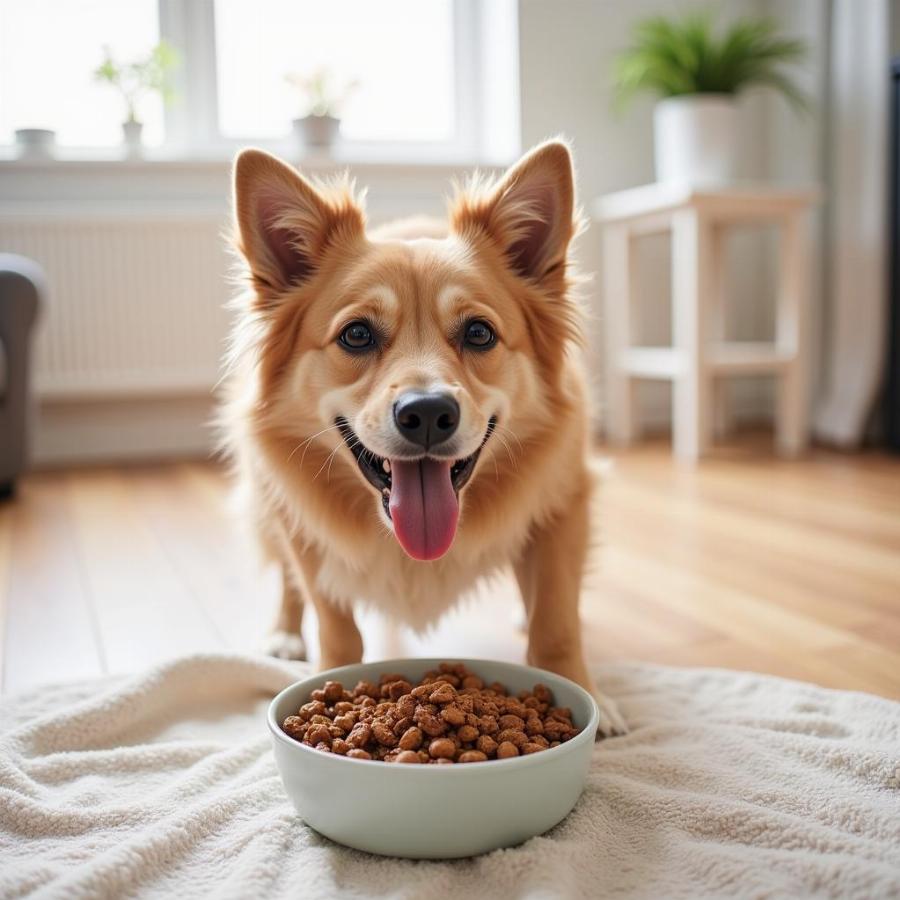Satiety food for dogs plays a crucial role in maintaining a healthy weight and preventing overeating. Choosing the right food can be a game-changer for your furry friend, helping them feel full and satisfied while avoiding the pitfalls of obesity. This article will delve into the world of satiety food, exploring its benefits, key ingredients, and how to choose the best option for your beloved canine companion.
Understanding Satiety in Dogs
What exactly is satiety food, and why is it important for your dog? Simply put, satiety refers to the feeling of fullness and satisfaction after eating. Just like humans, dogs can experience hunger and fullness cues, and satiety food is designed to promote that feeling of fullness, helping them regulate their food intake and maintain a healthy weight. This is especially crucial for dogs prone to overeating or those with weight management issues. Choosing a satiety food can help your dog stay satisfied between meals, reducing begging and the temptation to sneak snacks.
Key Ingredients in Satiety Food for Dogs
Several key ingredients contribute to the satiety factor in dog food. High-fiber content is essential, as fiber absorbs water in the stomach, creating a feeling of fullness. Look for ingredients like beet pulp, brown rice, and oats. Protein is another crucial component, as it helps maintain muscle mass and also contributes to satiety. Healthy fats, in moderation, also play a role in satiety and provide essential fatty acids for your dog’s overall health. Choosing a 30/20 dog food can be a good starting point for finding a balanced and satiating diet.
Choosing the Right Satiety Food for Your Dog
With so many dog food options on the market, choosing the right satiety food can feel overwhelming. Consider your dog’s age, breed, activity level, and any specific dietary needs. Puppies, adult dogs, and senior dogs have different nutritional requirements. For example, a highly active dog will need more calories and protein than a less active senior dog. Consult with your veterinarian for personalized recommendations. They can help you determine the best best dog food for weight maintenance for your furry friend.
How can I tell if my dog’s food is keeping them full?
Observe your dog’s behavior. Are they constantly begging for food between meals? Are they scavenging for scraps? If so, their food may not be providing adequate satiety. You might want to explore options like adding fiber supplements for dogs to their current diet or switching to a dedicated satiety food.
What if my dog has food sensitivities?
If your dog has food sensitivities, look for limited-ingredient diets or hypoallergenic formulas specifically designed for sensitive stomachs. These often incorporate novel protein sources like venison or duck. Knowing can dogs have wild rice or other grains can also help you make informed decisions about their diet.
Tips for Feeding Your Dog Satiety Food
Transitioning to a new food should be gradual to avoid digestive upset. Mix the new food with the old food, gradually increasing the proportion of new food over several days. Measure portions accurately to avoid overfeeding, even with satiety food. Provide fresh water at all times, as fiber absorbs water and helps promote hydration. Monitor your dog’s weight and adjust portions as needed.  Dog Eating Dog Food
Dog Eating Dog Food
Expert Insights on Satiety Food
Dr. Emily Carter, a veterinary nutritionist, emphasizes the importance of satiety food: “A satiated dog is a happy dog. By choosing a food that promotes fullness, we can help our canine companions maintain a healthy weight and avoid the many health problems associated with obesity.”
Another expert, Dr. Sarah Miller, adds: “Fiber is a key component of satiety food. It helps regulate digestion and keeps dogs feeling full and satisfied, reducing the urge to overeat.”
Conclusion
Satiety food for dogs offers numerous benefits, from weight management to overall well-being. By understanding the key ingredients and choosing the right formula for your dog’s individual needs, you can help them stay healthy, happy, and satisfied. Remember to consult with your veterinarian for personalized advice. Choosing the right food is an investment in your dog’s long-term health and happiness.
FAQ
- What is the best way to transition my dog to satiety food?
- Can puppies eat satiety food?
- How much satiety food should I feed my dog?
- Are there any side effects of satiety food?
- How can I tell if my dog is benefiting from satiety food?
- What are some other ways to help my dog feel full?
- Is how to supress appetite dogs a safe practice?